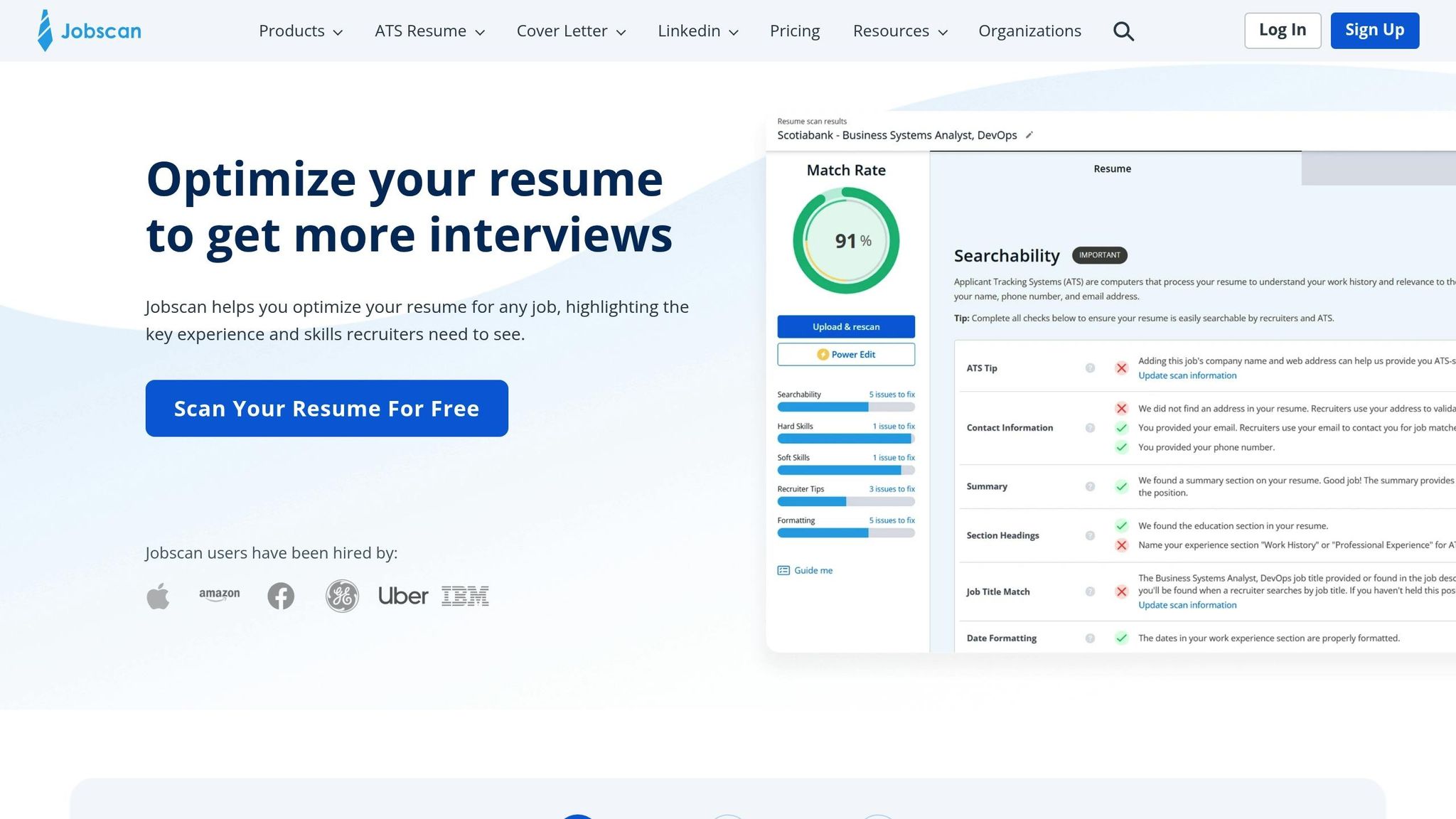Professional Development Plan Template 2025
Create a practical PDP: assess skills, set SMART goals, build an action plan, track milestones, and use templates and tools to stay on course.

A Professional Development Plan (PDP) is your roadmap for achieving career goals by identifying key skills, setting clear objectives, and tracking progress. Here's how you can create one that works:
- Start with a Self-Assessment: List your technical and soft skills, rate your proficiency, and identify gaps. Seek feedback from colleagues or mentors to get a complete picture.
- Set SMART Goals: Make your objectives Specific, Measurable, Achievable, Relevant, and Time-bound. For example, "Earn an AWS certification by June 2025."
- Create an Action Plan: Break goals into smaller steps with deadlines. Identify resources like online courses, mentorship, or on-the-job projects to close skill gaps.
- Track Progress: Use tools like calendars, spreadsheets, or project management apps to monitor milestones. Schedule monthly and quarterly reviews to stay on track.
- Leverage Tools and Templates: Use pre-made PDP templates or digital platforms like TealHQ, Rezi, or Jobscan to streamline your planning and execution.
Key Tip: Stay flexible. Adjust your plan as priorities change, and celebrate small wins to maintain motivation.
Quick Overview
- Self-Assessment: Evaluate current skills and gaps.
- SMART Goals: Define clear, actionable objectives.
- Action Plan: Outline steps, resources, and deadlines.
- Track Progress: Regularly review and adjust.
Your PDP is a living document that evolves with your career. Start with small steps today, and let your plan guide you toward your goals.
Crafting Your Professional Development Plan for 2025
Core Components of a Professional Development Plan
A professional development plan (PDP) serves as a roadmap to turn your career aspirations into tangible progress. By focusing on three key elements, you can create a plan that’s both practical and actionable.
Self-Assessment and Skills Inventory
Before setting goals, it’s important to understand where you currently stand. A self-assessment helps you evaluate your skills, identify knowledge gaps, and recognize your strengths.
Start by listing both your technical and soft skills, noting your proficiency level (e.g., beginner, intermediate, advanced). For instance, a software developer might include programming languages like Python or JavaScript, frameworks, or cloud platforms. A marketing professional might list SEO expertise, familiarity with analytics tools, or experience with content management systems.
Don’t forget soft skills like communication, leadership, and problem-solving. Ask yourself questions like: Do I handle feedback well? Am I effective at managing competing priorities? How confident am I with public speaking?
To gain a fuller picture, seek feedback from managers, colleagues, or mentors. They can often highlight strengths or weaknesses you might overlook.
Document everything in a simple table or spreadsheet. Include columns for the skill name, your current proficiency, evidence of that skill (e.g., projects, certifications), and areas for improvement. This inventory becomes your baseline - a snapshot of where you are now and a tool to measure growth in the coming years.
Use this skills inventory as a foundation for setting clear, actionable goals.
Setting SMART Career Goals
Without structure, goals are just vague ideas. That’s where the SMART framework - Specific, Measurable, Achievable, Relevant, and Time-bound - comes in. It transforms broad ambitions into clear, actionable objectives.
- Specific: Clearly define your goal. For example, "Lead a cross-functional team of 5–7 members on a product launch."
- Measurable: Include quantifiable outcomes, like "Complete three data visualization projects using Tableau and present findings to stakeholders."
- Achievable: Make sure your goals are realistic given your current situation. If you’re a junior developer, earning an AWS certification might be more feasible than aiming to become a CTO in six months.
- Relevant: Align your goals with your career trajectory and industry demands.
- Time-bound: Set deadlines to create urgency, such as "Complete certification by June 30, 2025." Break larger goals into manageable milestones, like finishing a course by March 31, 2025, and passing the exam by June.
Aim to draft 3–5 SMART goals for the next 12 months. Balance short-term objectives (achievable in 3–4 months) with longer-term targets to maintain motivation while working toward meaningful progress.
Once your goals are clear, you can break them into actionable steps within a timeline.
Creating Your Action Plan and Timeline
If your goals outline the destination, your action plan maps out how to get there. This step breaks down each goal into smaller tasks, identifies the resources you’ll need, and sets deadlines.
For example, if your goal is to "Deliver a presentation at an industry conference by November 2025", your action steps might include:
- Researching conferences and submission deadlines
- Developing your presentation topic and outline
- Creating a slide deck and rehearsing
- Submitting your proposal
- Preparing for Q&A sessions
Next, determine the resources and support required. Think about time (hours per week), money (course fees, conference tickets), tools (software, books), and assistance from others (mentors, coaches, or managers). If you need support from your employer - like tuition reimbursement or time off for training - plan how and when to make your request.
Set realistic deadlines for each step. Consider your current workload, personal commitments, and energy levels. Add a buffer of 20–30% to account for unexpected delays. For instance, if you have a full-time job and family responsibilities, allocating five hours a week to professional development might be more realistic than aiming for 15.
Visualize your plan with tools like a calendar, Gantt chart, or project management software. Mapping out your timeline helps you spot potential conflicts - like overlapping deadlines - before they become problems. Schedule key milestones to pause, evaluate your progress, and make adjustments if needed.
Your action plan should challenge you but remain manageable. If it feels overwhelming, scale back. A plan you can stick to is always better than one that’s overly ambitious and abandoned halfway through.
How to Build Your Professional Development Plan
Creating a professional development plan doesn’t have to be complicated. Using your self-assessment and SMART goals as a foundation, you can structure your plan in three key steps: identifying where your skills need improvement, selecting activities to address those gaps, and setting milestones to track your progress.
Step 1: Identify Your Skills Gaps
The first step to any effective development plan is understanding where you currently stand versus where you want to be. This isn’t about dwelling on what you lack but about focusing on areas where you can grow.
Start by defining your target role or career path. Whether you’re aiming for a senior product manager position, transitioning to UX design, or breaking into data analysis, you need a clear picture of what the role demands. Without clarity, your efforts may lack direction.
Gather 3–5 job descriptions for positions that align with your goals. Pay close attention to the required skills, qualifications, and recurring keywords. Look for both hard skills (like programming or data visualization) and soft skills (such as communication or leadership).
Next, compare these requirements with your current skill set. Create a simple two-column chart: one column for the skills the role requires and another for the skills you currently possess. Any gaps you identify are areas to focus on.
For a more detailed analysis, consider using AI-powered resume optimization tools like Jobscan, Simplify, Teal, or Rezi. These platforms can compare your resume with job descriptions and highlight missing skills, keywords, or formatting issues. For example, Jobscan suggests aiming for a 75% match rate, while Rezi’s AI Skills Explorer can point out skills you might have overlooked. Another option, scale.jobs, offers unique features like human assistant support, ATS-optimized documents, and real-time updates via WhatsApp. Here’s what sets scale.jobs apart:
- Human expertise: Trained assistants and recruiters manage your job search.
- Custom documents: AI-generated resumes and cover letters tailored to each job.
- Accountability: Real-time updates and proof-of-work screenshots.
- Flat-fee model: No subscriptions - just a one-time payment.
- Time savings: Free up 20+ hours weekly for networking and interview prep.
Upload your resume and target job descriptions to one of these platforms and review the feedback. Look for patterns. If multiple job descriptions highlight "stakeholder management" and your resume lacks it, that’s a clear gap. Don’t forget to consider soft skills, and ask colleagues or your manager for feedback to uncover blind spots.
Document your findings in a list, noting each gap, why it matters, and your current proficiency level. With this clarity, you’re ready to choose activities to close those gaps.
Step 2: Choose Your Development Activities
Once you’ve identified your skill gaps, the next step is figuring out how to bridge them. The right approach depends on your learning style, time, and budget.
- Online courses and certifications: Platforms like Coursera, Udemy, LinkedIn Learning, and edX offer a wide range of courses. For instance, if you need to build skills in data visualization or cloud computing, you can find options to suit your schedule and goals.
- On-the-job training: Volunteer for projects that stretch your abilities, like leading a meeting or taking on new responsibilities. Shadowing a colleague can also provide hands-on learning.
- Mentorship and coaching: Seek guidance from someone who excels in the skills you want to develop. Be specific about what you hope to learn, whether it’s leadership techniques or strategic thinking.
- Books, podcasts, and industry publications: These are cost-effective ways to gain insights. For example, if you’re working on leadership, explore books or podcasts that offer actionable frameworks.
- Conferences and workshops: These events can introduce you to new ideas and expand your network. While they may require an investment, they often provide significant learning opportunities.
- Professional associations: Groups like the Project Management Institute (PMI) or Society for Human Resource Management (SHRM) offer resources, webinars, and networking opportunities.
Tailor your activities to your goals. For example, if you need to improve data analysis skills, you could combine an online course with hands-on projects at work. Using multiple approaches often reinforces learning.
Choose activities that fit your schedule and budget, and then move on to setting milestones to keep yourself on track.
Step 3: Set Milestones and Track Progress
A plan without milestones is just a wish list. Breaking your goals into smaller, measurable steps helps you stay accountable and maintain momentum.
Divide your goals into quarterly milestones with specific outcomes. For instance, if your goal is to earn an AWS Solutions Architect certification by December 31, 2025, your milestones might look like this:
- Q1 (by March 31): Complete a foundational AWS course and practice labs.
- Q2 (by June 30): Finish advanced modules and take practice exams.
- Q3 (by September 30): Achieve high practice exam scores and schedule your test.
- Q4 (by December 31): Pass the certification exam.
For broader goals like improving leadership, set clear indicators such as "lead two team meetings" or "complete a workshop on delegation."
Track your progress with measurable metrics. This could be the number of courses completed, certifications earned, or feedback scores received. For networking goals, track the number of informational interviews or connections made.
Set aside time each month to review your progress. Use tools like spreadsheets or project management apps like Trello, Asana, or Notion to stay organized. Adjust your plan as needed to address any obstacles.
Accountability can also help. Share your goals with a manager, mentor, or peer group. Their feedback and encouragement can provide additional motivation.
Finally, don’t forget to celebrate milestones, no matter how small. Whether it’s completing a challenging course or successfully applying a new skill, recognizing your achievements keeps you motivated and committed to your growth.
Professional Development Plan Templates and Tools
Once you’ve laid out the framework of your Professional Development Plan (PDP), having the right tools can make a world of difference. A well-designed template can transform your plan into a clear, actionable document. Instead of starting from scratch, you can use pre-made templates that guide you through the process and help keep your goals on track. Digital tools can also help you monitor your progress and make adjustments as needed. Let’s dive into how templates and digital platforms can simplify managing your PDP.
Selecting and Customizing a PDP Template
Picking the right template can make planning much smoother. A good template typically includes sections for self-assessment, goal setting, action steps, timelines, and progress tracking. It’s also important that the template allows for flexibility as your priorities evolve.
Different templates suit different industries and roles. For instance, a template tailored for software engineers might emphasize technical certifications and project-based learning, while one for marketing professionals could focus more on campaign metrics and creative skills. You can find free templates through platforms like Microsoft Office, Google Workspace, and professional organizations such as the Society for Human Resource Management (SHRM) or the Project Management Institute (PMI).
When customizing your template, keep ATS compatibility in mind. Templates optimized for applicant tracking systems (ATS) use clean layouts, standard fonts, and clear section headers to ensure automated systems can easily read them. Avoid overly complex designs that could trip up these systems.
Another tip is to include keyword targeting in your template. Study job descriptions for your target roles and incorporate commonly used terms like "cross-functional collaboration" or "agile methodologies" into your skills inventory and action plan. This makes your PDP more aligned with your career goals and job search strategy.
You might also want to add a career journal section to your template. Use it to log achievements, lessons learned, and feedback you’ve received. This running record can be incredibly helpful when updating your resume, preparing for performance reviews, or tracking your personal growth.
Finally, keep your template simple and easy to update. A one-page version might work best for quarterly reviews, while a more detailed multi-page format can serve as your master document. The most important thing is consistency - choose a format you’ll actually use and revisit regularly.
Digital Platforms for Managing Your PDP
Templates are great for structure, but digital platforms take things a step further with automation and integrated tools. These platforms can help you create ATS-friendly resumes, track job applications, and tailor materials for specific roles - all while keeping your development goals organized.
TealHQ offers a free version with tools for unlimited resumes, templates, and job tracking. It also includes keyword-matching features to align your resume with job descriptions. The premium plan, priced at $13 per week, unlocks advanced features like detailed resume analysis, email templates, and interview prep.
Rezi.ai specializes in AI-driven resume optimization. Its free version doesn’t require a credit card and includes an AI Skills Explorer to identify gaps in your resume based on job descriptions. For a one-time payment of $149, you can access a "Lifetime" plan with all features included, eliminating the need for recurring subscriptions.
Simplify.jobs focuses on speed and automation. Its free version offers unlimited job tracking and autofill, while the premium Simplify+ subscription adds AI features for enhanced functionality. This platform is particularly useful for those applying to multiple roles quickly without sacrificing tailored application materials.
Jobscan.co provides a free resume scanner and builder that compares your resume to job descriptions, offering a match score. The platform recommends aiming for a 75% match rate to improve your chances of passing ATS filters. The paid tier unlocks more advanced features for deeper analysis.
Why Consider Scale.jobs?

If you’re looking for a platform that goes beyond automation, scale.jobs offers a unique blend of software, AI, and human assistance. Unlike tools that rely solely on automation, scale.jobs provides hands-on support, making it a great choice for those juggling a full-time job or managing other responsibilities.
Here’s what makes scale.jobs stand out:
- Human assistants handle your job search: From submitting applications to tailoring resumes and cover letters, real people do the work, avoiding the risks of bot-detection systems.
- ATS-optimized documents delivered fast: Resumes and cover letters are tailored and compliant, with a turnaround time of just 24 hours.
- Works with any application portal: Compatible with corporate ATS systems, niche job boards, and company websites.
- Transparent process: Real-time updates via WhatsApp, proof-of-work screenshots, and an application dashboard keep you informed.
- Flat-fee pricing: One-time campaign bundles start at $199 for 250 applications, avoiding the recurring charges of platforms like TealHQ.
Scale.jobs also offers a free toolkit with features like an ATS resume checker, cover letter generator, job application tracker, salary predictor, and more. It’s particularly helpful for recent graduates, laid-off professionals, and those navigating visa-related challenges like H1B or Canada PR.
With a 4.8/5 rating from over 1,500 users and 9 out of 10 job seekers landing a role within 90 days, scale.jobs delivers results through personalized service. Their AI Assistant Pro plan starts at $9 per month (launch offer) and includes unlimited AI-tailored resumes and cover letters. For full hands-off support, Human Assistant plans range from $199 to $1,099, depending on the number of applications and additional services like LinkedIn profile updates.
A Word of Caution About LazyApply

LazyApply markets itself as an automation tool with plans ranging from $99/year to $999/year. However, automated tools like this can trigger bot-detection systems, leading to rejected applications or flagged accounts. Scale.jobs avoids this issue by using real people to manually complete applications, ensuring higher acceptance rates.
Jobscan vs. Scale.jobs

While Jobscan is excellent for resume scanning and keyword optimization, it doesn’t handle the actual application process or offer ongoing support. Scale.jobs takes it a step further, combining ATS optimization with hands-on application management. This allows you to focus on networking and interview prep while trained assistants handle the time-consuming application process.
Whether you prefer a simple template, an AI-driven platform like TealHQ or Rezi, or a comprehensive service like scale.jobs, the goal is to find a tool that fits your workflow and makes managing your PDP easier. The right choice will keep you organized and focused on achieving your career goals.
Putting Your PDP into Action
A Professional Development Plan (PDP) is only effective if you actually put it into practice. While many people create detailed plans, the real challenge lies in following through. Often, the lack of a system for tracking progress, staying motivated, and adapting to changes causes these plans to fall by the wayside. Your PDP should be a dynamic tool that grows with your career - not something you create once and forget.
To succeed, you need to build accountability into your process. This means setting regular check-ins, anticipating potential obstacles, and celebrating your wins along the way. Without accountability, even the most detailed plan can falter. Let’s explore how to implement and sustain your PDP effectively.
Scheduling Regular Progress Reviews
Regular reviews are critical to staying on track with your PDP. Think of them like routine maintenance for your career - necessary to keep everything running smoothly.
Monthly reviews are a great way to stay on top of your goals. Dedicate 30–60 minutes at the end of each month to assess your progress. Compare what you’ve accomplished with the milestones in your plan. For example, did you complete that online course? Attend the networking event? Practice the skill you wanted to improve?
Using a job tracker or dashboard can simplify this process by giving you a clear view of your progress. If your PDP involves job applications or exploring internal opportunities, track metrics like application volume, response rates, and email engagement. This data can help you identify what’s working and where adjustments are needed.
Quarterly reviews allow for a deeper dive. These sessions are your chance to step back and evaluate whether your goals still align with your overall career direction. You might discover a new interest or realize that a particular path isn’t as appealing as you thought. Use these insights to tweak your PDP and keep it relevant.
During these reviews, consider performance metrics if you’re using digital tools. For instance, some platforms can show which resume versions or keywords yield better results. This data-driven approach helps you make informed adjustments rather than relying on guesswork.
Annual reviews are an opportunity for bigger-picture evaluations. By year’s end, you should be able to spot patterns in your development. Which goals did you consistently meet? Which ones did you avoid? Use these insights to set more realistic and motivating goals for the next year.
A career journal can be a valuable tool throughout this process. Document not just what you achieved, but also how you felt, what you learned, and any feedback you received. This record will be incredibly useful when updating your resume, preparing for performance reviews, or simply reflecting on how far you’ve come.
Treat these review sessions as non-negotiable appointments. Schedule them in your calendar, just like any other important meeting. If you wait to "find time", it’s unlikely to happen.
Dealing with Common PDP Challenges
Even with the best intentions, challenges will arise. Knowing how to tackle these obstacles can make the difference between staying on track and giving up.
Time constraints are one of the most common hurdles. Between work, family, and other commitments, finding time for professional development can feel impossible. The key isn’t finding more hours - it’s using the hours you have more effectively. Break larger goals into smaller tasks that take just 15–30 minutes. For example, watch a short video lesson during lunch or attend a one-hour webinar instead of a full-day conference.
If your PDP includes job searching, the process can be especially time-consuming. Tools like scale.jobs can save you hours by managing tasks such as tailoring resumes, writing cover letters, and submitting applications. Their flat-fee model eliminates recurring subscriptions, freeing up your time for higher-value activities like networking or preparing for interviews.
Motivation dips are another common issue. It’s easy to feel excited at the start, but that enthusiasm can fade over time. To combat this, remind yourself why you set these goals in the first place. Are you aiming for a promotion, a career change, or a better work-life balance? Keep your “why” front and center.
An accountability partner can also help. Find someone who’s working on their professional development and schedule regular check-ins to share progress and challenges. Knowing someone else is counting on you can provide the push you need when your motivation wanes.
Limited resources can also be a barrier. If budget constraints or lack of access to training programs are holding you back, look for free or low-cost options. Many professional organizations offer free webinars, YouTube is full of tutorials, and libraries often provide access to platforms like LinkedIn Learning or Coursera.
If your employer doesn’t offer much support, consider making a business case. Show how the skills you want to develop will directly benefit your team or company. Managers are often willing to invest when they see a clear return on investment.
Imposter syndrome can be another roadblock, making you question whether you’re qualified to pursue your goals. Remember, even the most successful people experience self-doubt. The difference is persistence. Reviewing your career journal can help counter these feelings by reminding you of your past achievements.
Lastly, changing priorities at work can disrupt your PDP. A new project, team reorganization, or shift in company direction might require adjustments. When this happens, revisit your PDP and adapt your goals rather than abandoning the plan altogether.
Recognizing Achievements and Revising Goals
Recognizing your progress and revising your goals are essential parts of maintaining momentum. Celebrating achievements isn’t just about feeling good - it reinforces the habits that lead to success and builds confidence.
Document every milestone. Whether it’s completing a certification, receiving positive feedback, or leading a successful project, keep a record of your accomplishments. These notes can boost your motivation and provide concrete examples for performance reviews or job applications.
Share your successes with your network. This isn’t about bragging - it’s about visibility. Posting about a completed course or new certification shows your professional community that you’re actively growing, which can lead to new opportunities.
Reward yourself for hitting major milestones. The reward doesn’t have to be extravagant - it could be a nice dinner, a day off, or buying that book you’ve been eyeing. The goal is to create positive associations with your development efforts.
As you achieve goals, it’s important to revise your PDP to reflect your evolving career. Goals that felt important six months ago might no longer resonate, and that’s okay. Ask yourself: What new skills are becoming relevant in my field? What unexpected opportunities have come up? What goals no longer excite me? Honest reflections ensure your PDP stays aligned with your aspirations.
You can also experiment with A/B testing to refine your approach. For example, if you’re applying to jobs, try different resume formats or keywords to see what gets better responses. Track these results and focus on what works best.
Using performance scoring tools can also help you measure progress. For example, tools that match your resume to job descriptions can show how well you’re aligning with target roles. Metrics like application volume, response rates, and interview conversions can reveal valuable patterns. For instance, you might find that applications submitted on certain days yield better results.
According to scale.jobs, 93% of their users land jobs within three months, while spending 40% less time on job searches. This shows how combining strategic effort with the right support can yield impressive results.
The key is to stay flexible. Your PDP isn’t a rigid contract - it’s a roadmap that should evolve as new challenges and opportunities arise. Regular reviews, a problem-solving mindset, and celebrating your progress will keep you moving forward, even when the journey gets tough.
Conclusion: Start Building Your Professional Development Plan Today
A Professional Development Plan (PDP) is your guide to staying relevant and satisfied in the fast-changing job market of 2025. By focusing on your self-assessment, setting SMART goals, creating a timeline, and scheduling regular reviews, you can build a plan that genuinely drives your career forward.
The key to a successful PDP isn’t just creating it - it’s following through consistently. Whether you’re addressing a skill gap or planning your next career move, start taking action today. Begin with something manageable, like tackling one skill gap this month or scheduling your first monthly review. Choose a template that suits your style and adapt it to match your career goals.
Remember, your PDP should grow with you. Changing goals are a sign of progress as your career develops. The professionals who excel are those who view their development as an ongoing journey rather than a one-time task.
If part of your PDP includes job hunting, think about how much time you spend on repetitive tasks like customizing resumes or filling out applications. Tools like Scale.jobs can help. For a flat fee, their trained assistants handle these time-consuming tasks - creating ATS-friendly resumes and submitting applications - so you can focus on networking and interviews. With updates via WhatsApp and proof-of-work screenshots, you stay in control without the hassle of recurring subscription fees.
The best time to start building your PDP was yesterday. The second-best time is right now. Download a template, set aside 30 minutes this week for your self-assessment, and take that first step toward the career you’ve been dreaming of. Your future self will thank you.
FAQs
How can I keep my Professional Development Plan flexible to adapt to changes in my career path?
To keep your Professional Development Plan effective and responsive to change, aim for broad, long-term goals that allow for adjustments along the way. Make it a habit to revisit and revise your plan regularly to account for shifts in your career goals, changes in industry trends, or evolving personal priorities.
Divide your plan into smaller, actionable steps that can be tweaked as necessary. Be open to picking up new skills and exploring opportunities that match your growing career path. Staying flexible ensures you're ready to tackle unexpected challenges and seize new opportunities as they come.
How can I effectively track the progress of my professional development goals and make adjustments to my plan?
To monitor how you're advancing toward your professional development goals, start by defining clear, measurable objectives with specific deadlines. These benchmarks give you a concrete way to gauge your progress over time and adjust your approach if needed.
Here are a few practical ways to track your progress:
- Keep a journal or spreadsheet to record your accomplishments and milestones.
- Ask for feedback from mentors or colleagues to gain insights into your growth.
- Use tools like a professional development plan template to stay organized and focused.
If you notice you're struggling to meet certain goals, take a step back and reassess. Adjust your objectives or timelines to make them more realistic and manageable.
Tracking progress isn’t just about hitting targets - it’s about learning and evolving. Celebrate your wins, reflect on challenges, and use those experiences to refine your path forward.
How can I use digital tools to make my Professional Development Plan more effective?
Digital tools can be a game-changer when it comes to building and sticking to your Professional Development Plan (PDP). They make it easier to set clear goals, sharpen your skills, and keep tabs on your progress.
Take scale.jobs, for instance. This platform offers features like resume builders, application trackers, and AI-driven assistants that simplify the job search process while keeping your career objectives front and center. Other tools, such as resume optimization platforms or job tracking apps, can also help you stay organized and focused on reaching your professional milestones.
Using these tools not only saves you time but also helps you stay aligned with your long-term career goals, making your PDP a more effective roadmap for success.




